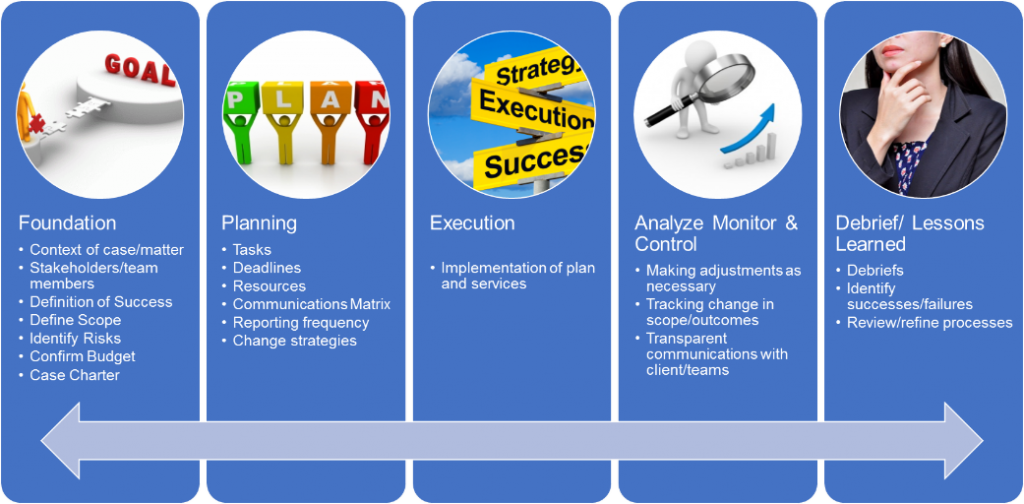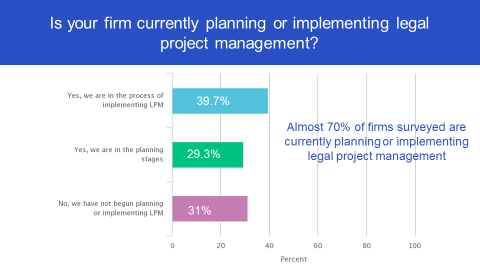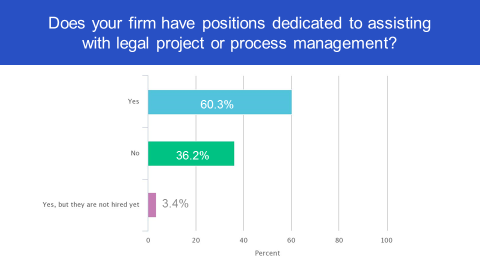We recently conducted a webinar on the “Legal Project Management vs Legal Process Management” debate and, I have to say, it was a well-attended event with great feedback–solid evidence that this is a topic on the minds of law firms and corporate law departments. More education and information is needed, hence this blog post.
So what really are the differences between the two terms? Actually, there are quite a few. In a nutshell, legal processes are those that make up the ‘human factor’ that controls the efficiencies of workflows to improve the replicability of legal work. All the legal processes, when glued together, make up the different components within legal project management.
In a book published by the American Bar Association in February 2014, legal project management was defined as:
“(1) a proactive, disciplined approach to managing legal work that involves defining, planning, budgeting, executing and evaluating a legal matter; (2) the application of specific knowledge, skills, tools and techniques to achieve project objectives (the client’s and law firm/legal department’s); and (3) the use of effective communication to set and meet objectives and expectations.” Lambreth and Rueff, ABA (February 2014)
I agree with this definition. I want to, however, emphasize the third component, ‘effective use of communication to set and meet objective and expectations,’ which is, in my opinion, the most critical. Without it, none of the other areas can succeed.
So how did the industry get here? When the financial market took a turn around 2008 clients realized they had a stake in legal services and demanded alternative fee arrangements. Clients no longer wanted to pay by the hour or pay for law firms inefficiencies. This is when legal project management really began to take form. Now, it’s not only law firms that have begun reworking their practices–it’s corporate law departments and general counsel as well.
Let’s take a look at some of the key phases within legal project management below:

You should identify what the areas are in each phase within your firm or law department. Ask yourself: what are the elements of the foundation, the beginning, the initiation of legal matters? Which areas need planning? When executing, what specifically is executed in this phase? When analyzing, what needs adjustments, what needs to be tracked, re-scoped, re-communicated, updated, and reported? When the matter is closing, what specifically were the successes and failures, and where do we need to refine or rework within the other four phases? How do you use your successes to build on future opportunities?
Ask each of your practices these questions. They may not all be the same; they may be similar, but not the same. Every firm and practice group will have slightly different perspectives. To measure the success of the initiative, be certain to define what the goal is and what success looks like. This is key.
We surveyed our webinar audience and asked the question, ‘Is your firm currently planning or implementing legal project management?’
We also asked, ‘Does your firm have positions dedicated to assisting with legal project or process management?’
This is good news, folks. Very good news. Almost 70% of firms surveyed are currently planning or implementing legal project and/or process management and approximately 60% of firms surveyed have dedicated positions.
In Part 2 of Legal Project Management vs Legal Process Management, we’ll take a look at the definition of legal process management, discuss the Process Readiness model, and share a case study on how one firm began its LPM endeavor.
So, where does your firm stand with implementing legal project management? Do you have executive buy-in? Are clients asking you how you manage your legal matters? What are your biggest concerns with legal project management? Feel free to share your comments and thoughts below.

